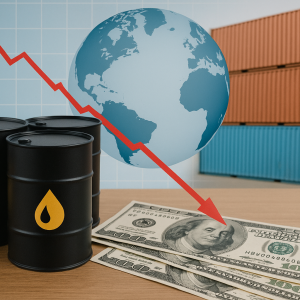Share on
Weak restart. Italian GDP came to a standstill in Q3, suffering from the decline in industry offset by growth in services. In Q4 the economy is estimated to recover slightly, driven by the tertiary sector and with the rate cut that may begin to ease consumption and investments. Exports remain negative due to the weakness of the Eurozone and the uncertain global scenario.
Falling rates. The Fed in November decided on the second cut in US rates (by -0.25, to 4.75%), following the first one in September. The ECB has already cut European rates three times (again by -0.25, to 3.25%). Both meet in mid-December for the last 2024 session: markets expect another quarter-point cut in both areas, as well as continued easing in 2025 (by a further point for the ECB).
Still high inflation in the Eurozone. In October in the Eurozone it is at +2.0%, on the ECB threshold: energy is still down (-4.6% per year), food is up (+2.9%), among core prices (+2.7%) those of services are hot (+3.9%), those of industrial goods cold (+0.5%). In Italy, trends are similar, but more moderate (+0.1% industrial goods): the result is inflation one point lower: +0.9% total, +1.7% core.
Gas more expensive, oil less. In October-November, the price of gas in Europe went up to EUR 40 per MWh, a jump of +57% from EUR 26 in February: this has an upward effect on the electricity prices paid by Italian households and businesses. Conversely, oil prices are more moderate compared to the peaks of the first part of 2024 (USD 85-90 per barrel), continuing to fluctuate between USD 74 and 76 from September to November.
Services grow. In Q3, services were the only growing sector, thanks to foreign tourism (+6.7% per year in August). The latest data are mixed: in September RTT (CSC-TeamSystem) indicates a moderate recovery in turnover; in October the PMI rose again (52.4, from 50.5), signalling growth at the beginning of Q4; however, business confidence fell, especially in transport services.
Construction down. Production in the construction sector declined in August (-1.8%) and from the peak at the beginning of the year dropped by -4.6%. In terms of turnover, RTT in September indicates that the sector is holding. Looking ahead, the end of incentives will prevail on the negative side, only partly offset by support from the NRP.
Weak investments. Judgments on conditions for investing worsened in Q3 (-7.7 the balance) and evaluations on capital goods orders fell in October (-25), anticipating a weak trend in plant-machinery investments. The cost of credit for businesses fell (-0.69% from highs).
Sluggish consumption. The indications are weak: in Q3 car sales fell by -6.6% (and by -0.8% in October), sales of other goods grew little (+0.4%). Moreover, household confidence fell in October to low values compared to 2018-2019, so the propensity to save may remain high. On the positive side, low inflation and the falling cost of credit (-0.28% from the peak).
Exports still falling. In the third quarter, Italian exports decreased further (-0.6% at constant prices), while imports showed an initial weak recovery (+0.9%) after two quarters of contraction. In October, negative signals for exports continued to come from judgments on foreign orders: the weakness of the Eurozone and Germany in particular weighed heavily. World trade, on the other hand, continued to grow (+0.7% in July-August over Q2), although the outlook is slightly worsening (48.3 PMI in October).
Eurozone: GDP good, not industry. Industrial production declined throughout the Area: in Q3 there was a sharp contraction in Germany (-1.9%), more than in Italy, and Spain also fell (-0.4%); France bucked the trend (+0.5%). The trend in GDP nevertheless denotes growth in the area in the 3rd quarter (+0.4%), driven by services: France was healthy (+0.4%), Spain (+0.8%) continued to be the most lively economy, and Germany's contribution was modest (+0.2%) after a declining 2nd quarter.
The industry in the US is also hurting. US GDP grew by +0.7% in Q3, thanks to the contribution of private consumption (+0.6%) and government spending (+0.2%), which offset the weakness of investment (+0.1%) and the decline in net exports (-0.1%). Industrial production, on the other hand, closed the quarter down (-0.3%); in October, the PMI and the Chicago index (47.4 from 35.4) remained at recessionary levels. Since the outcome of the US elections, the dollar appreciated (1.05, from 1.09).
In China, on the other hand, industry and exports did well. Chinese manufacturing is still expanding, albeit at a moderate pace. Production is sustained by foreign demand: in October, exports posted a monthly +12.7%, the highest growth in two years; Trump's election could induce strong expansion in the coming months, in anticipation of the possible introduction of tariff barriers from 2025. On the other hand, domestic demand remains sluggish and disappointment prevails at the delay in recovery policies: the government has announced USD 1.4 trillion over five years, but most of it is earmarked to pay off the debt of local authorities.
Fashion and cars sink Italian industry
The decline has eased, but continues. In the first 9 months of 2024, Italian industrial production fell by -3.3% compared to the same period in 2023. This was due to a marked decline in Q1 (-1.4% cyclically), which then gradually eased towards the end of spring (-0.9% in Q2). Nevertheless, Q3 data remained negative, with a further decline of -0.6%.
Fosco the future. The outlook for the coming months is linked to the recovery of consumption and investment in Italy and Europe, which will happen, but slowly, thanks to the slow rise in disposable income and the rate cut. Ordinary CIG in manufacturing increased by about 50% compared to the first three quarters of last year. The manufacturing PMI, which had approached the neutral threshold in the summer (49.4 in August) then fell back to 46.9 in October. Manufacturing business confidence has been weak for about a year, at modest levels and declining slightly recently (85.8 in October, from 86.6). Expectations for orders in manufacturing were still slightly down (balance of responses at 1.3 in October, from 1.8 in September; it was 2.3 in July).
Penalising energy. The prices of raw materials used by various manufacturing sectors have remained high, even after the end of the 2021-2022 price hike. This is especially the case for energy in Europe, which penalises the competitiveness of Italian companies, not only in the most 'energy-hungry' sectors.
Mixed trends. At sector level, very different performances emerge. Few sectors grew in 2024: other transport equipment (which includes armaments) and repair/installation register large increases (+8.2% and +5.4%, respectively), but food and paper also grew (+2.5% and +1.5%). Oil refining and chemicals held up. All other sectors, the majority, suffered. In particular, the automotive and clothing-textile-leather sectors are struggling.
Fashion sectors in deep crisis. In the first 9 months of 2024, production in the fashion-related sectors declined sharply: -15.1% in leather (after -9.9% in 2023), -9.5% in clothing (-2.5%), -5.9% in textiles (-8.2%). The authorised hours of lay-offs in the three subsectors as a whole more than doubled, exports recorded -4.5% in the first eight months, and turnover -9.0% at current prices. In the post-pandemic period, after a brief and lively recovery, the sector started to suffer (including luxury) and fashion companies (especially the smaller ones, but not only) saw a vertical decrease in orders, goods shelved in warehouses and consequent stalling in production, leading up to the sharp contraction that started in H2 2023, which does not seem to be stopping. Looking ahead, we do not see many positive signs: the wars in the Middle East and between Russia and Ukraine, the slowdown in Germany and in Chinese imports are cooling crucial markets for the sector; the inflationary flare-up has left end prices higher.
Collapse of the car industry. Production in the sector automotive in Italy (Ateco 29, including components and engines) is down -19.4% in the first 9 months of 2024 compared to the same months in 2023. In trend terms, we are at -32.4% in September, of which -42.7% for motor vehicles. The automotive sector is one of the main sectors of Italian manufacturing: it weighs 6.3% of production (13% in Europe, given the size of the sector in Germany), and with the allied industries, the weight rises even higher: its crisis, therefore, has a strong impact on the economy. What are the reasons for the production slump in the last year? The drop in demand, as can be seen from registrations (although imports are up slightly); changing habits, especially of young people (car sharing, rental, etc.); demographic trends; the sharply rising average price of new cars (+3.0% per year in 2018-2024, compared to +1.6% for the core inflation), in the wake of more on-board technology and an increase in vehicle size, but also due to the rising price of raw materials and energy; prices are too high for electrics: in 10 years, for the same model, the cost is +15% higher than for the endothermic; for electrics, there is (to date) the poor availability of recharging and lower autonomy.






















